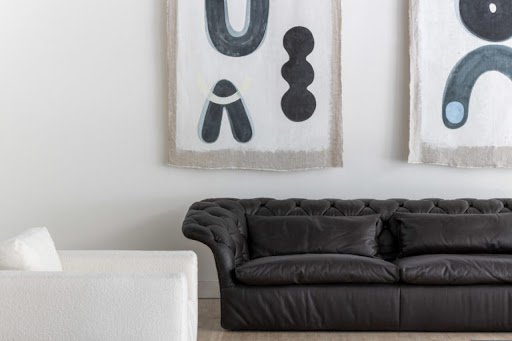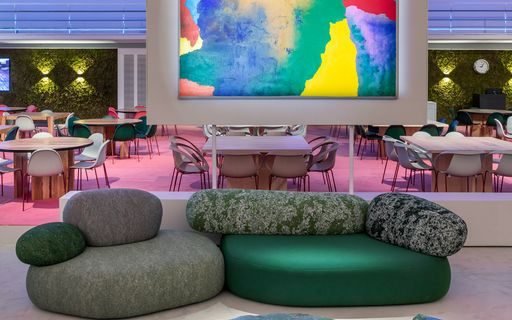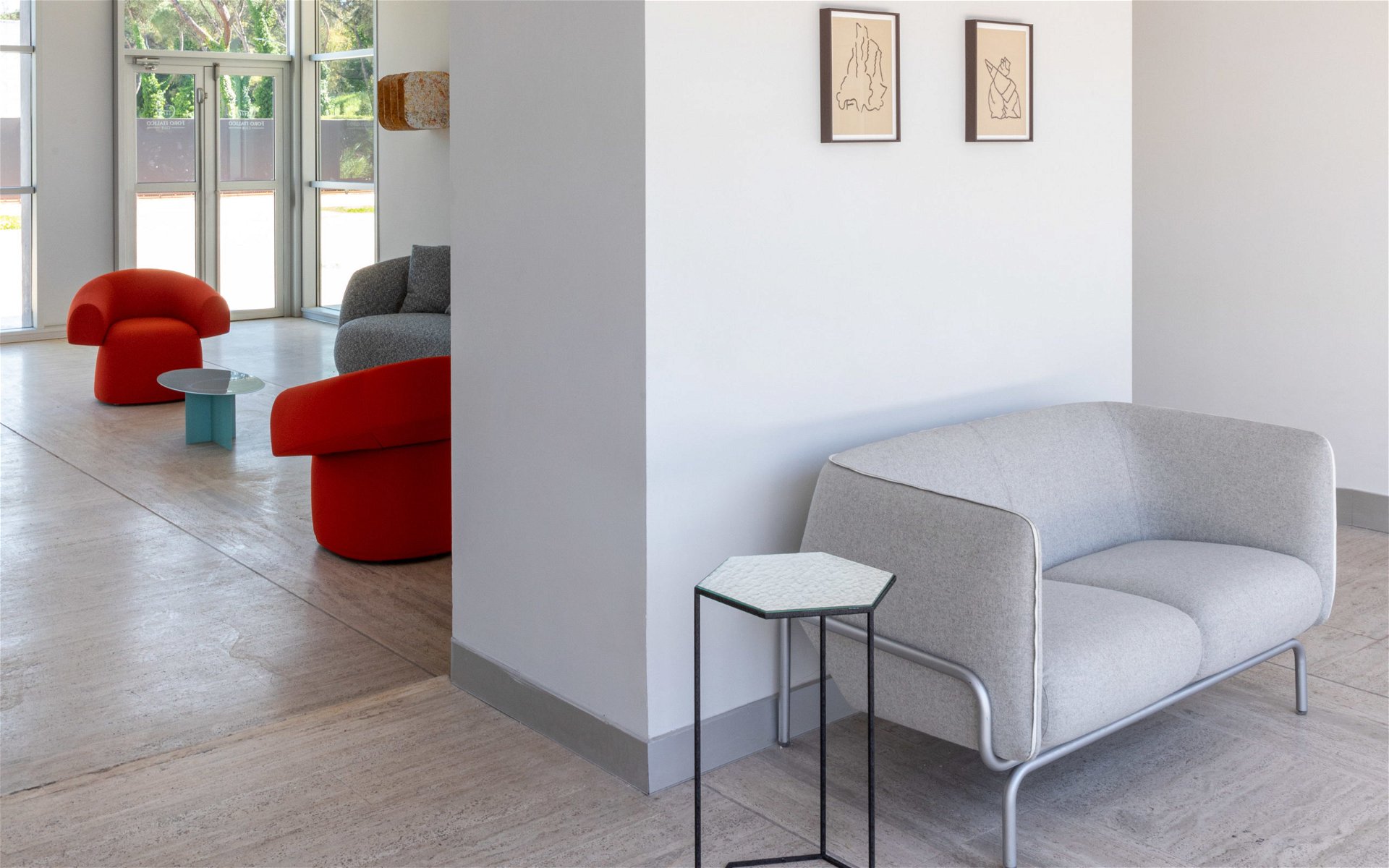Moroso is the Official Supplier of the Corporate Hospitality of the International BNL of Italy 2023

The title of the installation is a homage to its location, the Foro Italico, built between 1928 and 1937, the period of art referred to by art historians as Modern. In this context, the term “modern” means “belonging to the present.” But by “modern world,” we also imply a complex series of subjects that have influenced the future since the days of antiquity, a past in which Rome has always held a gravitational pull and served as a source of inspiration. The visit is intended to provoke in the visitor a series of visual suggestions between art and design that can evoke a romantic reflection on the evolution of form through the lens of Italian style.
For the first time this year, the LEA will be held at the Sala Delle Armi, a modernist edifice constructed by Luigi Moretti between 1933 and 1937. LEA, the organization behind Hospitality in Sport and Health for the BNL Italian Open, will host guests and sponsors of the tournament. It begins as a journey of art and design and continues into the corporate hospitality lounge within the Stadio Centrale del Tennis (Tennis Central Stadium).
Within the Sala delle Armi, there are three suspended walls that display the most recent cycle of works by Gianni Politi (Rome, 1986).The works were created using a collage technique from leftover canvas, cut into new forms–symbols of his fascination with form and tones that shape a symbolic relationship with the layering of time. The six pieces,250x180cm, are mounted symmetrically, respecting the architecture of the room and recalling the lines of the ceiling designed by Moretti. The project, a collaboration with MAXXI of Rome, seeks to underline the desire to elevate sporting events by incorporating content of cultural value. The pieces are on display between the restaurant, furnished with Moroso’s Impossible Wood chairs, and the lounge area in which the Pebble Rubble sofas, signed by the Swedish designers Sofia Lagerkvist and Anna Lindgren of Front Design for Moroso, evoke a sensory experience that gives them a central role. An engaging and intriguing illusion that appeals to the viewer and piques their curiosity, altering their perception of time: “The collection is inspired by forms found in nature. We 3D scanned rocks we saw on our many forest walks and composed these organic shapes together into furniture pieces.”(Front Design)
Continuing toward the tennis stadium along Viale delle Olimpiadi, there is the maxxi poppy installation by STARTT, an architecture and landscape transformation studio. On the occasion of the 2023 BNL Italian Open, they are back and shining once more, transforming the famed Foro Italico complex with an evocative garden in bloom.

Upon reaching the Central Stadium, another four artists engage in dialogue with the architecture of the four corporate rooms located behind the bleachers of the stands. The Foro Italico Club (FIC) Room is host to works by Andrea Sala(Como, 1976): Sala offered a series of drawings on small-scale canvas paper for the occasion, entitled Frutta Bucata (2022) (“Pierced Fruit”). This series expresses the author’s interest in a tale that starts from the dawn of humanity and the history of art, an evolution of the still-life into sensual forms, and an outlet for a sculptural language. Here, it takes shape through two works: il trittico Piscine(2022) (“The Swimming Pools Triptych”), in green pastels, water on travertine, that recalls the forms of three historic swimming pools, including that of Salvador Dalí, and La biblioteca (sospensione)(2020) [“The Library (Suspension)”], that seeks to recall the distinct style of radiator-shaped shelving, a design halfway between domestic reality and fantasy. On the parapets behind the central court, four drawings on paper by Marta Mancini echo the sinuous lines of Andrea Sala’s works and furnishings in a more intimate way, foreshadowing the structure of his paintings placed in the next room.
Iconic Moroso designs have been chosen to furnish the FIC, in contrasting forms and materials. These include the Pacific sofa, with its soft forms emphasized and defined by the complete absence of edges and by its “couture” touches, paired with a Ruff armchair. Together, using simple geometry, these capture the essence of the interaction between sharp and curved lines that dovetail with the architecture of the surrounding space. The finishing touch to the space is the Pipe miniature sofa by Sebastian Herkner for Moroso. Its structure is built with a powder-painted 80mm aluminum tube, upon which rests a seat cushion that hints at the idea of the inflatable module. With Pipe the Gogan armchair, designed by Patricia Urquiola for Moroso, which takes its name from Japanese stones rendered smooth by time and water.

As you walk into the Montemario Sud room, the path crosses with the graphic sign structure through a selection of sculptures and paintings by Marta Mancini (Rome, 1981) who is showcasing her most recent series of paintings, in which she delves into an archaic painting technique that is intended as an abstract and traditional form of expressionism. The interior leans on dark grey tones and small splashes of colour, adding a sense of life to a sophisticated room in which the eye is drawn to the Gogansofa with its terrazzo fabric and the Getlucky armchairs by Patricia Urquiola for Moroso. At the far end is the Tabasettee, “the entwinement of form and poetry, the linear with the elusive,” says the designer Alfredo Häberli.
In the Montemario Nord room, the graphic sign path continues with a series of paintings on rough jute by Alice Ronchi (Milan,1989): the works entitled Universe(2022-2023), which play off the rigidity of the architecture of the room, are intended to guide the observer to reflect on the importance of roots and tradition of graphic signs as elements of evolution of the individual. The interior consists of faint colours between white and pastel shades that offer a backdrop to the works. The Bohemian sofa, a “liquid” reinterpretation of the classic padded couch, is matched with Salan Nanà arm chairs designed by Annabel Karim Kassar for Moroso. In contrast, there is the Square settee and small armchair, designed by Jonathan Olivares for Moroso.
The path ends in the Presidential Room, where the recent photographic study of the Foro Italico by Giovanna Silva (Milan,1980) is displayed in two formats, to offer a comprehensive understanding of the installation and the inside of the historic sporting complex. Through its contemporary vision that covers modern elements, equipment, architectural adjustments, as well as daily life, it has formed a layer effect of multiple ages. For the interior, iconic sofas are used that were designed as innocent reflections which go through an accumulative process, unconscious pen strokes, doodles; it starts with a single line and ends with an elaborate and complex piece. It is merely the pretext for the embroidery. The sofa design takes its shape from a folded blanket. Doodle by Front for Moroso.
About Moroso Moroso was founded in 1952, the brainchild of Agostino Moroso who, together with his wife Diana, founded the company with the aim of manufacturing sofas, armchairs and furniture, based on a production model which balances industrial processes with handcrafted techniques and finishes. In the '80s, the second generation of the family began an in depth process of research into quality design, led by Patrizia in artistic direction and Roberto on the business side.
